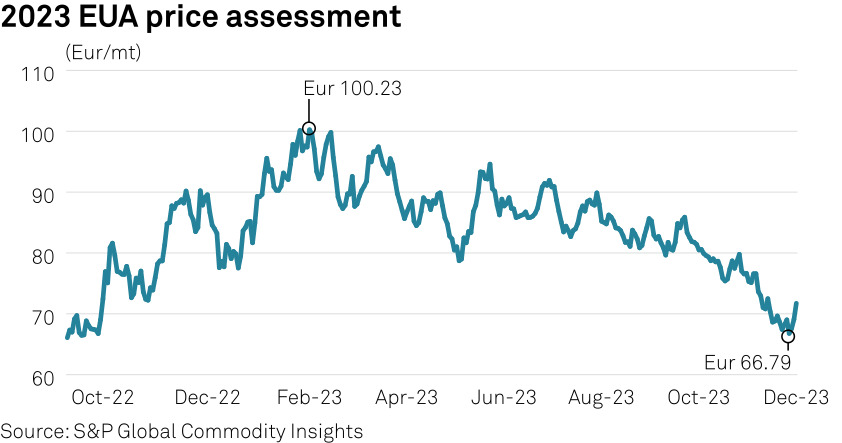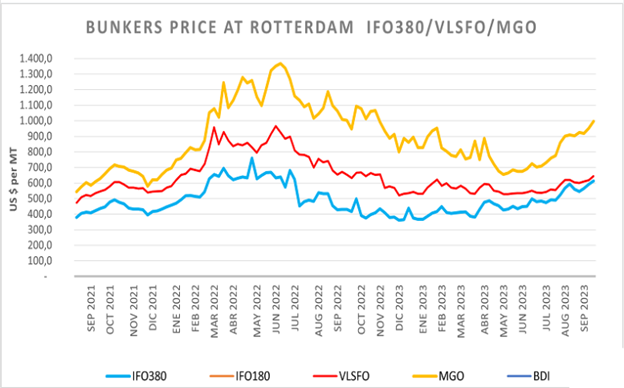The recently released report “Insights on Fuel Choice & EUA Trading for Shipping Players Under the EU ETS” written by Engine Technologies Pte and Freight Investor Services (FIS) provides clear insight into both the cost of carbon within the EU and the importance of fuel choices for ship operators trading within EU waters. The EU Emissions Trading System (EU ETS) comes into force on 1 January 2024. However, the first payments will be required in 2025 for the carbon consumed in the previous year. The carbon pricing for ships is discounted in 2024 by 60% and 30% in 2025 with the full price being paid in 2026.
Figure 1 below, courtesy of the S&P Global Commodity Insights, shows the volatility of carbon pricing in 2023 with a high point of €100 per metric ton of carbon emitted with some estimates having it hit €130 per ton by 2030. Using an average of the 2023 price a KWh of energy consumed will have a carbon cost of €0.06 on top of the bunker price of the fuel consumed.

Figure 1: 2023 Range of EU Allowance Pricing
Daily, ship-owners face challenges in reducing environmental impact and coping with the impact of rising fuel costs on their operability. The operators of cruise ships are particularly vulnerable to public opinion as the ships are perceived as luxury items that berth in the most exotic areas of the planet and due to their nature consume large amounts of fuel.
As fuel prices have varied greatly over the last two years, shown in Figure 2, budgeting has become increasingly difficult. Operators have invested heavily in various solutions to reduce fuel consumption. Therefore reducing both energy costs and green house gas emissions.
Some solutions include significant technical upgrades which require large investments and are invasive to the ship:
- Repowering e.g. Windstar Cruises “Star Plus” project
- Fitting scrubbers
- Upgrading underwater hull paint to low friction options
- Upgrading electrical consumers like motors or light fittings
- Designing ships to use alternate fuels
- Fitting cold ironing (shore power) arrangements for use in port
Others are considered more Operational Enhancements:
- Itinerary planning to reduce steaming distances or speeds
- Route execution to include weather routing and speed management

Figure 2: Rotterdam Bunker Princes 2021 to 2023
HVAC (heating, ventilation and air conditioning) tends to be the second largest energy consumer on large passenger vessels such as cruise ships and ferries after propulsion. Dutch sustainability technology company Arkitech International believes that through the applied use of the power of artificial intelligence significant reductions in energy consumption can be achieved by the optimisation of the HVAC system. These savings are made without large investments in infrastructure or the need to take the vessel out of service.
For cruise ships that generally trade in warm climates and spend long periods in port, the HVAC’s proportion of total energy consumption is increased. Arkitechs’ technology reduces the energy wasted in through chillers being set at too low a temperature and thus reduce emissions. Therefore, Arkitech allows cruise ship operators to demonstrate a reduction in their environmental footprint. Subsequent achievinging significant savings on their fuel and carbon costs.
The ARK-M20 technology has already been tested on two large ferries operating in the Mediterranean. Next to that, it is currently undergoing further trials on a major cruise ship with results expected in Q1 2024.